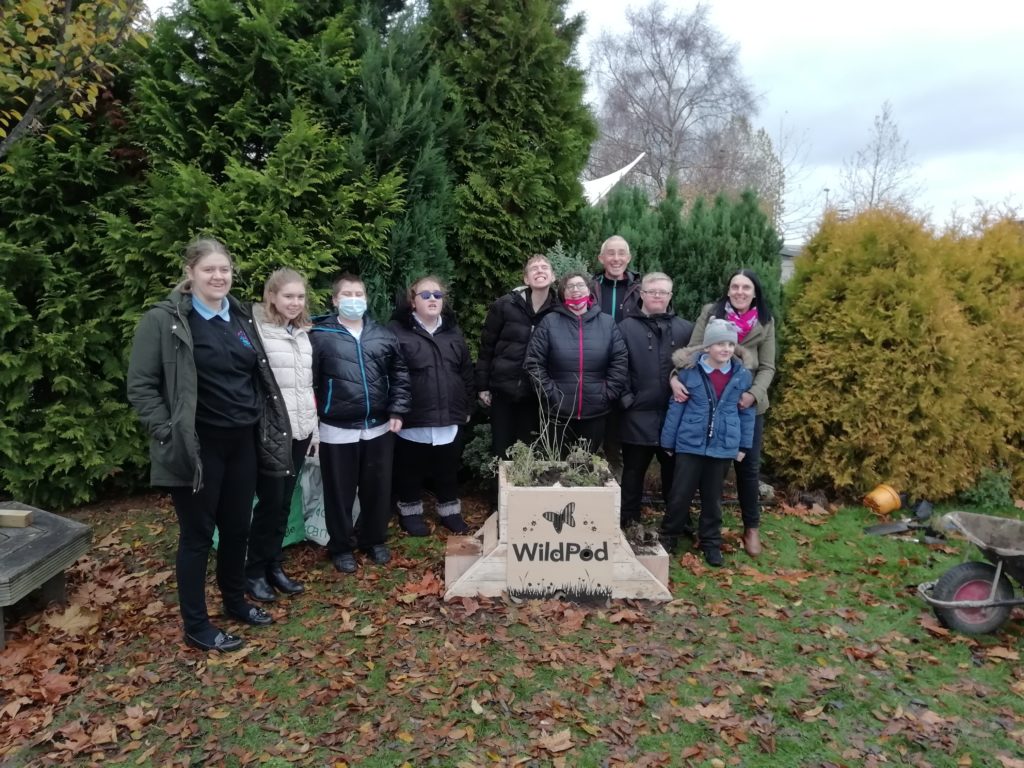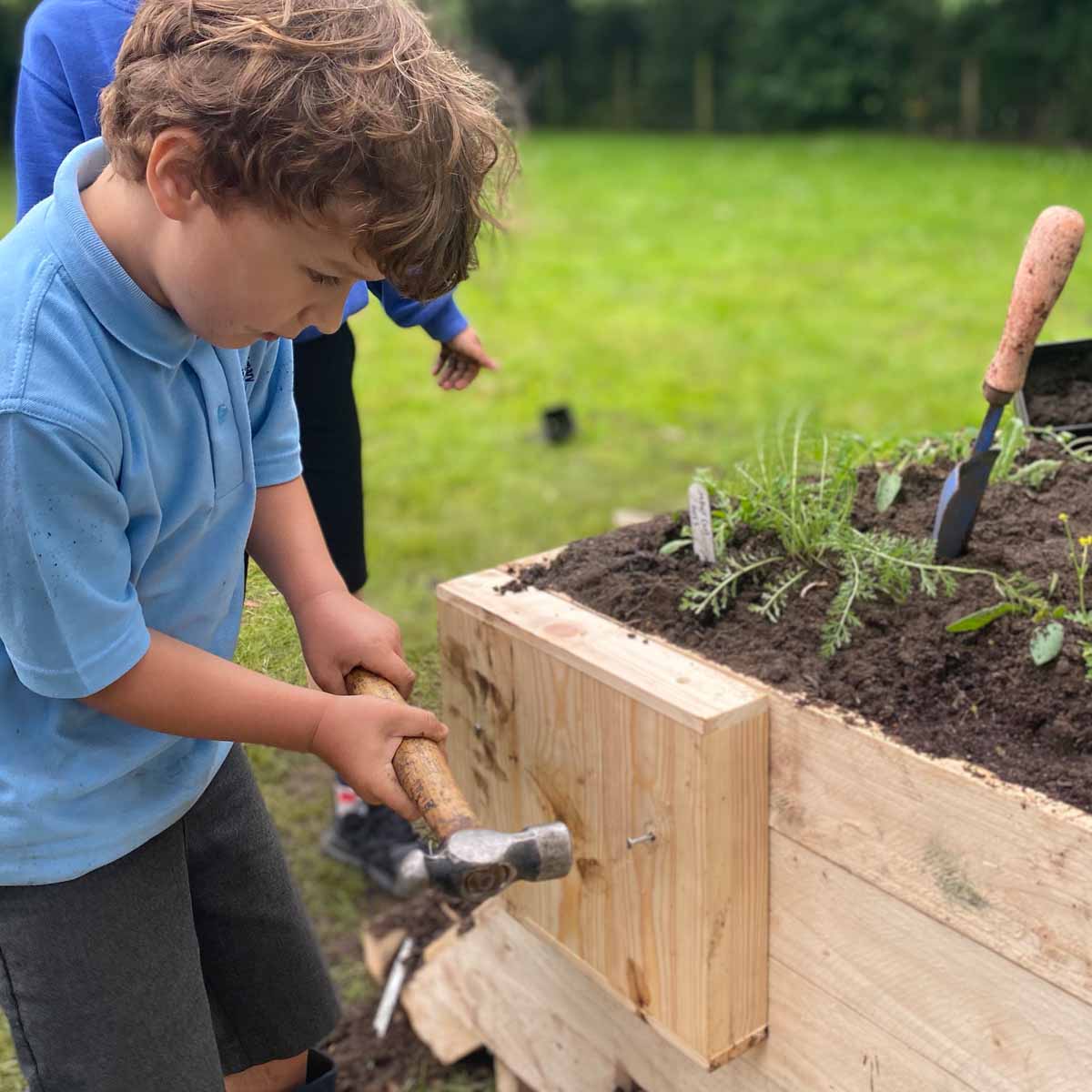From time spent in the fresh air to learning about ecosystems, schools are already experiencing multiple benefits from interacting with BioScapes products, as you’ll see below.
Adelaide Primary – inner city school expands scope of learning facilities
Adelaide Primary serves a very diverse community in the centre of Hull. The community sits within one of the most deprived areas of the UK, and, as a result of busy roads close by, is one of the most polluted playgrounds in the country. Mature trees and a large area of greenspace mitigate this to some extent and the school has placed much effort in the development of wild greenspace as part of the learning environment. NatureArk was placed at the edge of the existing forest school area to expand the scope of learning facilities.

BioScapes habitat units provide a simple, creative project for all to get involved in and we have received very positive feedback from children, teachers and parents.
Wilberfoss Primary School – village school builds on biodiversity education
Wilberfoss Primary School installed a NatureArk as part of their plans to expand on what they were doing for biodiversity in relation to the school curriculum. The school already has a pond, a garden area and trees but the NatureArk was seen as a way to involve the children from all year groups from the start of the process.
“The installation went really well, and the children haven’t stopped talking about it. They have taken real ownership from adding the soil to planting the wildflower plugs, with the children all working well together, sharing tasks, tools and making sure that the younger ones felt involved.
So far, we have used it as an opportunity for the children to care for plants and observe their growth. We plan to use it regularly as part of science lessons and intend to plan some whole school projects around it.
The foundation stage children have been exploring and looking for clues about what wildlife has been visiting the NatureArk. They were most excited to find fox prints!” – Miss Pemberton, Assistant Head, Wilberfoss Primary
Elvington Primary School – village school develops environment manifesto
Under their environment programme, Elvington Primary School chose a WildPod as a way to enhance the biodiversity of the grounds and revitalise their science garden. Children, teachers and parents all took part in setting up their WildPod and used this as a springboard for developing an environment manifesto as part of the Life on Our Planet initiative (https://www.ourplanet.com/en/schools-and-youth/).
“It was wonderful to receive a WildPod, which now sits proudly in our Science Garden! The children cannot wait to find out which creatures utilise the space and consequently develop their knowledge of biodiversity…” – Mr Andrew Buttery, Headteacher
Riverside Special School – adds to sensory resources for children with learning difficulties
Focused on encouraging learning outside the classroom, Riverside Special School has a wonderfully diverse site which allows staff to engage and extend the learning of the students. WildPod provided a new and exciting feature to the sensory garden and something the students could follow the development of through the year.
“I like to see what animals and bugs we have at school. I can’t wait to see which ones come to visit!” – Luke, student.

Some more feedback
Children and adults have provided the following feedback on NatureArk.
1. Why were you attracted to NatureArk?
“We loved the design and that it was all in one unit and that it contained so many different areas for different plants and different creatures!”
“We are looking to expand what we are doing for biodiversity. We feel like we are at the beginning of this.”
2. How did installation go?
“Smoothly and quickly! It was lovely for the children to be involved planting it up and collecting materials for the invertebrate and amphibian areas of the NatureArk.”
“Very well! Children from every year group got involved – adding soil and planting the wildflower plugs. Thoroughly enjoyed by everyone involved. The children haven’t stopped talking about it and have really taken ownership of caring for the NatureArk. It was great to do it alongside Terry who had amazing knowledge about the plants and explained so well to the children.“
“The children all worked very well together, sharing tasks and tools and making sure the younger ones felt involved.”
3. How have you used NatureArk so far?
“All the classes in the school have been out and accessed the NatureArk and had an explanation of what it was and what it does (we included this in the teacher training). The children also interact with the NatureArk during free play in the Forest School area. The school have had to create a rota as the area has been so popular since the teacher training.”
“So far, we have used it as an opportunity for the children to care for plants and observe growing. We plan to use it regularly as part of science and would like to plan some whole school projects around it.”
4. What responses have you had from staff and pupils?
“Everyone loves it! It’s fantastic to see the children watching the wildlife on the flowers. Their curiosity has really been stimulated and this has created some fantastic conversations.”
“We saw a wriggly worm.”
“Worms don’t like the sun but like a bit of rain.”
“I hope hedgehogs come to our school and use the NatureArk”
“We are all so excited to have a NatureArk in our school. We want to really expand what we do for biodiversity but feel we are at the beginning of our journey. NatureArk is a beautiful addition to the school and provides great learning opportunities, especially in science.”
5. Who is benefitting?
“Our whole school and the wildlife in our area.”
“Everyone! Children and staff will definitely benefit from this.”
“Staff use the area for meetings.”
“Year 6 children have taken responsibility for the NatureArk – making sure it’s looked after, finding material for the invertebrate shelter, and involving others.”
6. What are your plans for NatureArk and how will it feature in the curriculum?
“We love going out to see the area and the NatureArk and we cannot wait to watch it change through the seasons. It is relevant to the curriculum in each year group, from basic plant ID in year 1 and talking about the different creatures that visit the NatureArk and their body parts to year 6 looking at classification and identifying which plants and belong to different taxonomic groups.”
“With a focus on mental health and wellbeing and the benefit of being outside, this will be an invaluable resource! We plan to use it as part of our nurture programme.”
7. Overall, what would you say about BioScapes and would you recommend to others?
“Very efficient and good communication. Well organised. Yes, we would!”
“I would absolutely recommend! The expertise has been invaluable. It has been great that it feels like a collaboration rather than just something that has just been installed.”
“The vision of how the NatureArk could be used but also leaving room for our ideas has been useful for us.”


